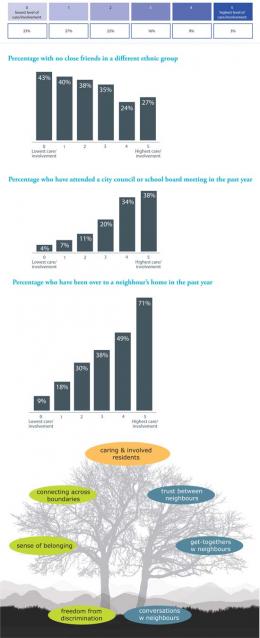Vancouver: United or Divided?

Connections and Engagement: A Closer Look is a
study by The Vancouver Foundation. Almost 4,000 people
from our city participated in this study.
Small Steps to Big Change
Vancouver Foundation’s 2012 Connections and Engagement Survey found that most neighbourhood connections in metro Vancouver are weak, most residents do not participate in any form of community activity, and forging meaningful relationships is a challenge for many, particularly across barriers of difference such as ethnicity.
The survey goes a long way toward understanding how people experience life in the region. It measures the scope and strength of relationships with friends, neighbours and people in the larger community. It measures attitudes towards others. It measures participation in activities that make neighbourhoods and communities better places to live. And it explores the barriers that prevent people from connecting and engaging.
What the survey did not do was examine what people need in order to move from being isolated, indifferent to one another and disengaged from community life, to being caring and involved citizens.
We asked Sentis Market Research to use the data from the survey to create a model that would show the drivers that can change people’s attitudes and influence their actions.
Caring and Involved Residents Scale
Sentis began by analyzing the attitudes and actions of all 3,841 survey participants. Then they created a scale from 0 to 5 that they called the Caring and Involved Residents scale and put all respondents on that scale based on how they responded to five measures.
People who scored 0 had the lowest levels of connection and engagement across the five measures. People who scored 5 had the highest. This means they:
1. were the most optimistic about their neighbourhoods
2. felt their neighbours would work together to solve local problems
3. participated in neighbourhood and community projects in the last year
4. attended a neighbourhood and community meeting in the last year, and
5. volunteered in the last year.
The table shows that just 28 per cent of survey participants received a score of 3 or higher, meaning they answered in the positive direction on at least three of the five items.
Validating the Caring and Involved Residents scale
Sentis validated the Caring and Involved Residents scale by proving the connection between it and the characteristics of strong, vibrant neighbourhoods and communities that we measured in the survey. Here are three examples.*
1. Connecting across cultural and ethnic boundaries
The Caring and Involved Residents scale does not include any variables that tap directly into residents’ relationships or attitudes toward different cultural groups. However, as scores on our scale increase, so does the likelihood that residents will attend cultural and ethnic events different from their own culture, and the likelihood that they will have close friends in an ethnic group different than their own.
2. Civic participation
Higher scores on the Caring and Involved Residents scale are strongly associated with attendance at school board and city council meetings, and with the likelihood that residents will sign petitions. The survey results showed that these forms of participation were also associated with participation closer to home—for example, getting together with neighbours, participating in a neighbourhood or community event—as well as a greater sense of trust among neighbours and a willingness to help neighbours.
*The full set of tables is in the Sentis report, From Connection to Engagement: Pathways to a More Caring and Involved Citizenry, at www.vancouverfoundation.cda/connect-engage
3. Neighbourhood relations
Leave a comment









